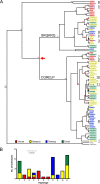Recurrent Loss of APOBEC3H Activity during Primate Evolution
- PMID: 29925657
- PMCID: PMC6096791
- DOI: 10.1128/JVI.00971-18
Recurrent Loss of APOBEC3H Activity during Primate Evolution
Abstract
Genes in the APOBEC3 family encode cytidine deaminases that provide a barrier against viral infection and retrotransposition. Of all the APOBEC3 genes in humans, APOBEC3H (A3H) is the most polymorphic: some genes encode stable and active A3H proteins, while others are unstable and poorly antiviral. Such variation in human A3H affects interactions with the lentiviral antagonist Vif, which counteracts A3H via proteasomal degradation. In order to broaden our understanding of A3H-Vif interactions, as well as its evolution in Old World monkeys, we characterized A3H variation within four African green monkey (AGM) subspecies. We found that A3H is highly polymorphic in AGMs and has lost antiviral activity in multiple Old World monkeys. This loss of function was partially related to protein expression levels but was also influenced by amino acid mutations in the N terminus. Moreover, we demonstrate that the evolution of A3H in the primate lineages leading to AGMs was not driven by Vif. Our work suggests that the activity of A3H is evolutionarily dynamic and may have a negative effect on host fitness, resulting in its recurrent loss in primates.IMPORTANCE Adaptation of viruses to their hosts is critical for viral transmission between different species. Previous studies had identified changes in a protein from the APOBEC3 family that influenced the species specificity of simian immunodeficiency viruses (SIVs) in African green monkeys. We studied the evolution of a related protein in the same system, APOBEC3H, which has experienced a loss of function in humans. This evolutionary approach revealed that recurrent loss of APOBEC3H activity has taken place during primate evolution, suggesting that APOBEC3H places a fitness cost on hosts. The variability of APOBEC3H activity between different primates highlights the differential selective pressures on the APOBEC3 gene family.
Keywords: APOBEC3H; African green monkey; evolution; human immunodeficiency virus; innate immunity; lentiviruses.
Copyright © 2018 American Society for Microbiology.
Figures






Similar articles
-
The activity spectrum of Vif from multiple HIV-1 subtypes against APOBEC3G, APOBEC3F, and APOBEC3H.J Virol. 2012 Jan;86(1):49-59. doi: 10.1128/JVI.06082-11. Epub 2011 Oct 19. J Virol. 2012. PMID: 22013041 Free PMC article.
-
Flexibility in Nucleic Acid Binding Is Central to APOBEC3H Antiviral Activity.J Virol. 2019 Nov 26;93(24):e01275-19. doi: 10.1128/JVI.01275-19. Print 2019 Dec 15. J Virol. 2019. PMID: 31578294 Free PMC article.
-
The resistance of human APOBEC3H to HIV-1 NL4-3 molecular clone is determined by a single amino acid in Vif.PLoS One. 2013;8(2):e57744. doi: 10.1371/journal.pone.0057744. Epub 2013 Feb 28. PLoS One. 2013. PMID: 23469063 Free PMC article.
-
A conflict of interest: the evolutionary arms race between mammalian APOBEC3 and lentiviral Vif.Retrovirology. 2017 May 8;14(1):31. doi: 10.1186/s12977-017-0355-4. Retrovirology. 2017. PMID: 28482907 Free PMC article. Review.
-
Role of the single deaminase domain APOBEC3A in virus restriction, retrotransposition, DNA damage and cancer.J Gen Virol. 2016 Jan;97(1):1-17. doi: 10.1099/jgv.0.000320. Epub 2015 Oct 20. J Gen Virol. 2016. PMID: 26489798 Free PMC article. Review.
Cited by
-
APOBEC3C Tandem Domain Proteins Create Super Restriction Factors against HIV-1.mBio. 2020 Apr 28;11(2):e00737-20. doi: 10.1128/mBio.00737-20. mBio. 2020. PMID: 32345636 Free PMC article.
-
A 25 Immune-Related Gene Pair Signature Predicts Overall Survival in Cervical Cancer.Cancer Inform. 2022 Apr 19;21:11769351221090921. doi: 10.1177/11769351221090921. eCollection 2022. Cancer Inform. 2022. PMID: 35464777 Free PMC article.
-
Polymorphisms in Human APOBEC3H Differentially Regulate Ubiquitination and Antiviral Activity.Viruses. 2020 Mar 30;12(4):378. doi: 10.3390/v12040378. Viruses. 2020. PMID: 32235597 Free PMC article.
-
Variability in Codon Usage in Coronaviruses Is Mainly Driven by Mutational Bias and Selective Constraints on CpG Dinucleotide.Viruses. 2021 Sep 10;13(9):1800. doi: 10.3390/v13091800. Viruses. 2021. PMID: 34578381 Free PMC article.
-
Divergence in Dimerization and Activity of Primate APOBEC3C.J Mol Biol. 2021 Dec 3;433(24):167306. doi: 10.1016/j.jmb.2021.167306. Epub 2021 Oct 16. J Mol Biol. 2021. PMID: 34666043 Free PMC article.
References
Publication types
MeSH terms
Substances
Grants and funding
LinkOut - more resources
Full Text Sources
Other Literature Sources

